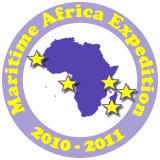
News: 27 Jun 2010, Praia | |
  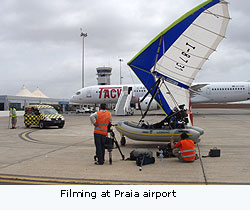 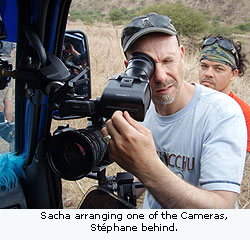     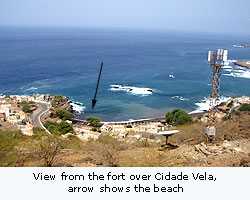  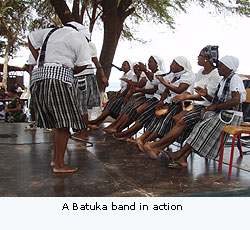 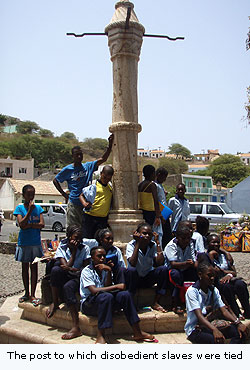  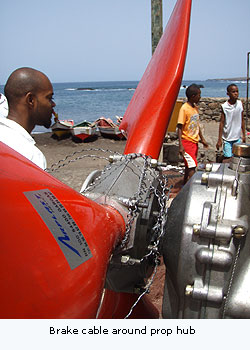
| There were several nasty moments today, result, I am OK, propeller is a bit shredded and the film crew are delighted. Where to start? Basically there's a gale in the Cape Verde islands all the time, it's the trade winds. Sal was ghastly, and a gale. Santiago, almost the most southerly of the islands, with the capital Praia seems a much nicer place. It is still a desert island with only 10 inches of rain a year, but it has mountains and is the real thing rather than some artificial resort. It is still windy, but there does seem to be the possibility of lighter winds in the early morning, there is agriculture, albeit for the most part survival rather than subsistence, and the people; that's what really makes this place, they couldn’t be nicer. It was less than an hour's flight in a small turboprop from Sal to Praia. They did get all our stuff on, the film crew were 180 Kg overweight and a bit of negotiation on the apron ensured my two blue barrels were stuffed into the rather small cargo hold too. Luckily there wasn't a full passenger list so they could balance it out by making us all sit at the front. The FIB was waiting for me in a warehouse Ivo had organized. I had no real idea how small Aimaro had packed it in its crates, and once I started opening it, I discovered it was very well packed, but rather completely dismantled. I think this will be a bit of a problem for the future because it is packed in a 'one-time' sort of way rather than the repeatable kind of crating system we will need for all the expeditions. So it was a very hot day's work in an oven of a warehouse to assemble the machine, and tricky in as much as I have never actually assembled a Polaris before. Still, it looked OK and we loaded it onto a small truck to take it to the airport. No real problems getting in. seems they are expecting me and had organized a place to put it in the fire station Next morning I was to do an 'arrival' at the airport for the cameras, which basically meant several circuits so they could film me from several different angles , and then taxi in to a parking slot next to a Cabo Verde Airways Boeing where I would meet Stéphane for the first time to start our adventure. Flight plan completed (I've never had to do one for a local flight before!) there was a slight technical delay while I had to swap the brakes over so it actually turned left when you intended left while taxiing (rather than the opposite), and took off for my two circuits. A strong wind, but straight off the sea with no turbulence and all went well. Despite being the capital city there are not so many other aircraft movements here so the tower were very relaxed about things, film crew were happy. Then I was told shooting for tomorrow involved scenes of Stéphane and I in a truck with the FIB on the back, driving to Tarrafal at the other end of the island, with us 'getting to know each other' on film. So I had to derig it and load it onto a truck, a better one this time into which it actually fitted without hanging out the back, and we spent the afternoon driving up and down switchback roads on steep hills in the centre of the island with cameras stuck to the outside of the truck looking in, and lights and microphones in unobtrusive places. This is a very rugged place, really quite high mountains with people living in small houses and working the land on impossibly steep slopes. Plenty of goats, a few pigs and cows wandering about, they all seem quite street-wise, perhaps the ones that weren't are dead. Quite what they eat is difficult to see, but I'm told the place actually goes quite green in September, and certainly there is plenty of evidence of where they grow maize and cassava, but right now it is very dry indeed. Yesterday we went to Cidade Vela, the original capital of the Cabo Verde islands, chosen because it is at the mouth of a deep 'unescapable' gorge into which slaves from West Africa were put before being sent on to the Americas. Last year it was declared a World heritage site by UNESCO and there was going to be a Fiesta on the first anniversary of this honour. The original plan was for Stéphane and I to fly there from the airport but it was very late by the time we got back from driving up and down hills, the FIB was still on the truck, and it is already clear to me that if I'm ever going to land on the sea here it's got to be very early morning, if we're lucky and the wind is light. I also knew that Cidade Vela is not really endowed with a very good anchorage and was abandoned after Sir Francis Drake bombarded and sacked the place in the 16th Century in favour of Praia which has a much better natural port. All in all then, the sensible thing was to go there by car, pretend we had landed; film Stéphane photographing the fiesta and we would do the actual arrival the next day. This would give us a chance to check it out and I could get back to the airport in the afternoon to unload and rig the FIB. Do you land on the sea? The French have the word 'amerrisage' instead of 'atterrisage' but the best I can think of in English is 'alight' which doesn't seem quite right. I think I shall use 'amerrisage' from now on. Cidade Vela is rather a pretty place reached by a precipitous cobbled road, about 30 minutes from Praia. The shady town square just by the beach has a sort of stone monument to which disobedient slaves were apparently attached, and a stage had been set up. I went to inspect the beach which is mostly rocky apart from a short bit at the extreme eastern end which was black sand where the locals pull out their fishing boats. The water was quite calm but a quite large swell occasionally caused quite big waves to crash onto the beach. I decided the trick would be to try to follow a wave in and you would be able to get right up onto the beach without the unpredictable effects of encountering a breaking wave. Back in the square quite a large crowd had assembled, speeches were made, and [I think] the minister of culture unveiled a sign declaring this a World Heritage site. Then the music started. There were several traditional Batuka groups which involves a single singer plus several assistants with their backs to the audience and scarves tied round their hips with the knot at the back to enhance their very wiggly dance, and they face a row of seated ladies who beat not really drums but a sort of leather pillow, sometimes with considerable gusto. It was all rather fun, and I expect made excellent film footage, Christian seemed happy anyway. Back at the airport later that afternoon my friends the Bomberos helped me unload the FIB from the truck and I rigged the machine and repaired the rear undercarriage locking down system which had somehow got bent, and fuelled it up ready for the morning. I filed a flight plan with ATC and told them I would close it by phone after I'd landed at Cidade Vela. They seemed quite calm about the novelty of an aircraft not landing in an airport. So early this morning, not much wind, Stéphane and I took off at about 7.30 to fly round to Cidade Vela. Film crew promised to be in position on the battlements of the old Portuguese fort up on the mountain next to the gorge by the time we got there. There are no small aircraft or helicopters in Cabo Verde so the plan for me to fly down the gorge below them was the next best thing to air-to-air shots. We did a careful first pass looking for cables and then several flights down the gorge as planned. Film crew satisfied, they moved down to the beach and I did some low passes and circles over the sea for them. I made a slight mistake on one pass and ended up with the choice of hitting a tree on the beach front or heading up the gorge the wrong way at very low level, the gorge seemed the better option, but for how long? I nailed the throttle, the climb rate is not good at all on this machine two-up, did the gorge go up steeper than I could? A few heart pounding minutes later I discovered it could, just, but there was no way we would get to a height to fly out of the gorge before it ended in a cliff. Only option was to make a turn, which actually ended up less tricky than at one stage I thought it might. A nasty moment . Stéphane was certainly given an introduction to a wide range of English expletives while all this was happening. In retrospect, there's plenty of stuff out there advising of the dangers of flying up valleys which go up steeper than you can and are not wide enough to turn in, so all you can do is wait for the crash. Luckily I could turn, this time, but I will be trying a lot harder not get into situations like this in future. Wheels up, rudder down, drain plug closed. Judging by the way a catamaran was lying at anchor there was not much wind at sea level at all, perfect for my first ever amerissage in the sea. Once down, my plan was to keep it on the plane, judging the speed such that I could drive it straight onto the beach behind a breaking wave but it didn't quite work out like this because on about the third wave top we hit there was suddenly the nasty noise of something in the prop, I looked round to see a wire hanging off the wing so I cut the engine. Once we came to a halt my first action was to secure the wing, and get onto the bow with a paddle to keep the thing facing into wind or there was a real big risk of us blowing over. Christian later said he had absolutely no idea what was going on, but whatever it was, it looked good and told the cameraman to keep rolling no matter what. In this horribly windy place we were incredibly lucky that just where were was sheltered by a small headland and there was really no wind at all, nevertheless we were drifting quite fast towards some rocks so we both paddled away from them. Next problem was how to get in over the surf which we would not be able to do at sufficient speed by paddling. Stéphane asked if I had a rope, and indeed I had, 50m of it in fact, stowed in the bow locker. Stéphane leapt in and swam to the beach with the end of the rope and the crowd of people pulled the FIB in to the beach with no further drama. Christian was delighted with the drama of it all. I was pissed off at shredding the tips of my expensive propeller on almost the first flight. What had happened was the impact of hitting a wave had caused the left side brake cable to bounce just enough to catch in the prop, it then ripped it off the connections to brake drum and rudder and wrapped itself around the prop hub. The wire I saw hanging down from the wing was just a bit of it which had been thrown into the air and got caught round one of the lines, but there was no damage apart from prop, which I thought repairable, and the need for a new brake cable, which I didn't think would be difficult to find in town. Why had it happened? It was something I had tested, and with the wheels down the cable can't reach the prop, but , as we discovered, it can with the wheels up. A simple plastic tie-wrap better securing the brake cable in the first place would have prevented it. The FIB was derigged and returned to the airport for repairs. Christian wants to film me looking for a new brake cable in town tomorrow. And I did remember to call the airport to close my flight plan. We all retired to the beach side restaurant to watch the football. There's probably only one thing worse than watching England being beaten by Germany in the World Cup, and that's being with a bunch of Germans, watching Germany beating England in the World Cup... |
Home
8 Jul 2011, Video clips
28 Jun 2011, Message from the producer
17 June 2011, Postscript
27 Sep 2010, Dar again
23 Sep 2010, Chumbe
20 Sep 2010, Zanzibar again
18 Sep 2010, Bullfight
17 Sep 2010, Kervan Saray
16 Sep 2010, Pemba
14 Sep 2010, Nungwe
12 Sep 2010, Popobawa
11 Sep 2010, Zanzibar
9 Sep 2010, Teddy Junior
26 Aug 2010, Ursula
26 July 2010, Home
17 Jul 2010, Just in time
15 Jul 2010, No wind
13 Jul 2010, Mindelo again
11 Jul 2010, Grogue
9 Jul 2010, Ponta do Sol
7 Jul 2010, Goal
5 Jul 2010, Independence day
4 Jul 2010, Wind
2 Jul 2010, Mindelo
31 Jun 2010, SS Tarrafal
30 Jun 2010, Tarrafal
27 Jun 2010, Praia
23 Jun 2010, Sal
20 Jun 2010, Bonding in Munich
29 Apr 2010, Lake Trasimene
Mauritius
Wind
Cape Verde
20Kt wind probability
Zanzibar
Talks & Presentations
RMH pilot CV
